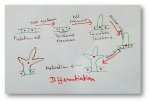Measurement of Volume
We will discuss here about the methods of measurement of volume of a substance. Liquid substances do not have any specific shape. It takes the shape of the container in which it is kept. So we cannot measure liquid with a measuring tape or a scale. But we can measure the volume of a liquid very easily.
We know the volume of a substance is the space occupied by it. The unit used for measuring the volume of a liquid is liter (I). We use this unit to measure volume of milk, water, etc. To measure the volume of smaller quantity of liquid like medicines, chemical substances, etc., we use milliliter (ml). It is a very small unit of volume. One thousand milliliters make a liter.
Liquid occupies the space in any container it is kept. So we can measure the volume of a liquid with the help of a graduated container. It is called a measuring cylinder. It is a glass jar with a flat base having equal diameter all along its length. The wall of the cylinder is graduated in milliliter.
To measure
the volume of a liquid we have to pour the liquid within the measuring cylinder
and observe the upper surface of the liquid perpendicularly. The mark in the
graduation that coincides with the top level of the liquid, indicates its
volume in milliliter. With different measuring cylinders we can measure liquid
from 50 ml to 500 ml.
To measure volume of petrol, kerosene, etc., typical cone shaped measuring containers are used. Such containers are of different sizes and are used to measure different quantities of liquid. The size of the containers may vary from 500 ml to 5 liters.
From Measurement of Volume to HOME PAGE
Recent Articles
-
Plants Development | Definition | Leaf Development | Factors Affecting
Apr 22, 25 02:31 PM
Definition of development- development is a biological process which can be defined as the process in which there is sequence of qualitative changes towards a higher or more Complex state.It consists… -
Differentiation, Dedifferentiation and Redifferentiation | Definition
Apr 21, 25 01:16 PM
Cells from the root apical meristem and shoot apical meristem the camera that differentiate , mature to perform different functions. This process by which the cells undergo different major structural… -
Explain about Growth in Plants |Definition of Growth & Differentiation
Feb 27, 25 02:07 PM
Growth is a permanent increase in length or volume of an organism that brought upon by an increase in its dimensions due to synthesis of new protoplasmic material. -
Definition of Respiratory Quotient | calculation | Application | Plant
Dec 02, 24 12:09 AM
Definition of respiration quotient- the ratio of the carbon-dioxide evolved to that of the oxygen consumed by a cell, tissue, plants or animals in a given time is called respiratory quotient. It is us… -
Amphibolic Pathway | Definition | Examples | Pentose Phosphate Pathway
Jun 06, 24 10:40 AM
Definition of amphibolic pathway- Amphibolic pathway is a biochemical pathway where anabolism and catabolism are both combined together. Examples of amphibolic pathway- there are different biochemical…



New! Comments
Have your say about what you just read! Leave me a comment in the box below.